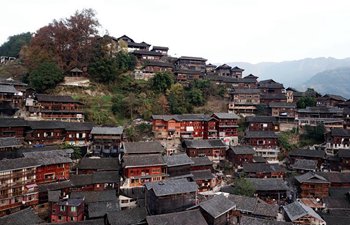CHANGSHA, Dec. 10 (Xinhua) -- A large-scale drainage system was discovered in the Yongshun old Tusi fortress in Central China's Hunan Province, shedding light on why the 800-year-old rampart is still standing today.
Located in Yongshun County in the Tujia-Miao Autonomous Prefecture of Xiangxi, the fortress was first built in the year 1135 A.D. Lying at the bank of a river, it is considered the largest, oldest and best preserved Tusi fortress in China.
The Tusi system was an ancient chieftain system adopted by feudal Chinese emperors to govern ethnic minorities in the southwest from the 13th to the early 20th century. "Tusi" refers to a tribal leader appointed as an imperial official by the central government.
A 44-meter-long city wall consisting of two layers was unearthed during the latest round of excavation of the fortress, which started this October, and researchers discovered a drainage ditch between the two layers of walls.
Steps were built in each length of the ditch, and large square or round stones were placed near the bottom of the discharge outlet in the ditch.
"When floodwater from the mountain rushed through the ditch, the large stones would protect the wall and city gate from being directly hit by the torrents," said Zhang Tao, an expert from Hunan Provincial Institute of Cultural Relics and Archaeology.
According to Zhang, the fortress was built on steep slopes on the mountain to protect it against invaders, but this made it vulnerable to mountain torrents. The design of the large drainage ditch and the large stones at the bottom protected the walls from the water, and may have been the reason the walls could survive for centuries.
After several rounds of archeological research and excavation on the ancient fortress and its periphery since 2010, a total of 12,000 relics have been unearthed and archeologists have gained a clear picture of its layout, road networks and the buildings in the fortress.
The Yongshun old Tusi fortress was the hub of the Tusi regime of the Peng family, which lasted 818 years and had jurisdiction over a vast area of minority tribes in southwest and central China.
The Yongshun old Tusi fortress, the ruins of Hailongtun castle in Guizhou Province and the Tangya Tusi fortress in Hubei Province were added to the World Cultural Heritage List in July 2015.



















